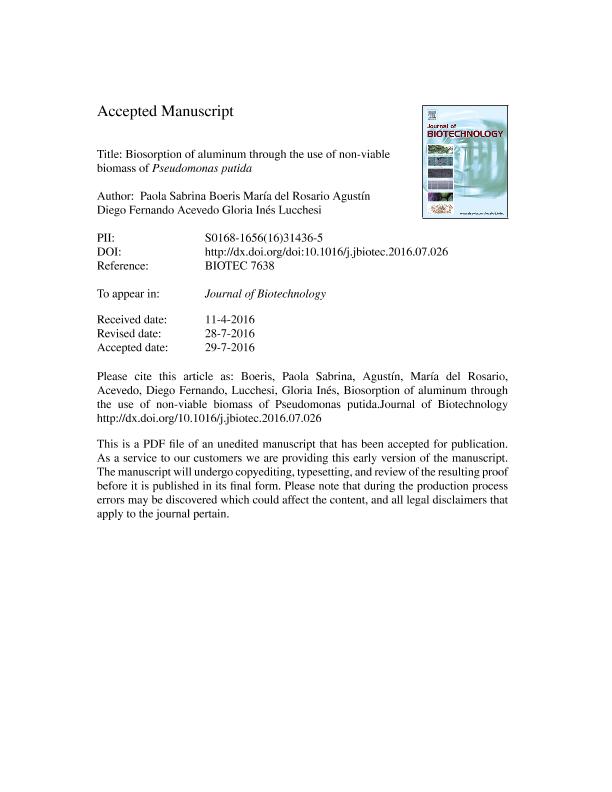Mostrar el registro sencillo del ítem
dc.contributor.author
Boeris, Paola Sabrina

dc.contributor.author
Agustín, María del Rosario

dc.contributor.author
Acevedo, Diego Fernando

dc.contributor.author
Lucchesi, Gloria Ines

dc.date.available
2022-12-02T15:16:34Z
dc.date.issued
2016-07
dc.identifier.citation
Boeris, Paola Sabrina; Agustín, María del Rosario; Acevedo, Diego Fernando; Lucchesi, Gloria Ines; Biosorption of aluminum through the use of non-viable biomass of Pseudomonas putida; Elsevier Science; Journal of Biotechnology; 236; 7-2016; 57-63
dc.identifier.issn
0168-1656
dc.identifier.uri
http://hdl.handle.net/11336/179997
dc.description.abstract
Living and non-living biomass of Pseudomonas putida A (ATCC 12633) was used as biosorbent for the removing of Al3+ from aqueous solutions. The process was stable with time, efficient at pH 4.3 and between 15 °C and 42 °C. Two isotherms models were applied to describe the interaction between the biosorbent and Al3+. Non-living biomass of P. putida A (ATCC 12633) was found to be the most efficient at adsorbing Al3+ with a maximum sorption capacity of 0.55 mg Al3+/gr adsorbent and with 36 × 105 binding sites of Al3+/microorganisms. Infrared spectroscopy analysis shows that the biosorbent present some vibrational band of functional groups that change in presence of Al3+: hydroxyl, carboxyl and phosphate. Considering that Al3+ binds to the phosphate group of phosphatidylcholine, non-viable biomass of P. putida PB01 (mutant lacking phosphatidylcholine) was used. Aluminum adsorption of the parental strain was 30 times higher than values registered in P. putida PB01 (36 × 105 sites/microorganism vs 1.2 × 105 sites/microorganism, respectively). This result evidenced that the absence of phosphatidylcholine significantly affected the availability of the binding sites and consequently the efficiency of the biomass to adsorb Al3+.
dc.format
application/pdf
dc.language.iso
eng
dc.publisher
Elsevier Science

dc.rights
info:eu-repo/semantics/openAccess
dc.rights.uri
https://creativecommons.org/licenses/by-nc-nd/2.5/ar/
dc.subject
ALUMINUM
dc.subject
BIOSORPTION
dc.subject
PSEUDOMONAS PUTIDA
dc.subject
TOXIC METALS
dc.subject.classification
Biología Celular, Microbiología

dc.subject.classification
Ciencias Biológicas

dc.subject.classification
CIENCIAS NATURALES Y EXACTAS

dc.title
Biosorption of aluminum through the use of non-viable biomass of Pseudomonas putida
dc.type
info:eu-repo/semantics/article
dc.type
info:ar-repo/semantics/artículo
dc.type
info:eu-repo/semantics/publishedVersion
dc.date.updated
2022-12-01T14:16:37Z
dc.journal.volume
236
dc.journal.pagination
57-63
dc.journal.pais
Países Bajos

dc.journal.ciudad
Amsterdam
dc.description.fil
Fil: Boeris, Paola Sabrina. Universidad Nacional de Río Cuarto. Facultad de Ciencias Exactas Fisicoquímicas y Naturales. Departamento de Biología Molecular; Argentina. Consejo Nacional de Investigaciones Científicas y Técnicas. Centro Científico Tecnológico Conicet - Córdoba; Argentina
dc.description.fil
Fil: Agustín, María del Rosario. Universidad Nacional de Río Cuarto. Facultad de Ciencias Exactas Fisicoquímicas y Naturales. Departamento de Biología Molecular; Argentina. Consejo Nacional de Investigaciones Científicas y Técnicas. Centro Científico Tecnológico Conicet - Córdoba; Argentina
dc.description.fil
Fil: Acevedo, Diego Fernando. Universidad Nacional de Río Cuarto; Argentina. Consejo Nacional de Investigaciones Científicas y Técnicas. Centro Científico Tecnológico Conicet - Córdoba; Argentina
dc.description.fil
Fil: Lucchesi, Gloria Ines. Universidad Nacional de Río Cuarto. Facultad de Ciencias Exactas Fisicoquímicas y Naturales. Departamento de Biología Molecular; Argentina. Consejo Nacional de Investigaciones Científicas y Técnicas. Centro Científico Tecnológico Conicet - Córdoba; Argentina
dc.journal.title
Journal of Biotechnology

dc.relation.alternativeid
info:eu-repo/semantics/altIdentifier/url/http://linkinghub.elsevier.com/retrieve/pii/S0168165616314365
dc.relation.alternativeid
info:eu-repo/semantics/altIdentifier/doi/http://dx.doi.org/10.1016/j.jbiotec.2016.07.026
Archivos asociados
